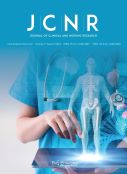Clinical Research on Treatment of Migraine with Combination of Characteristic and Superior Techniques of Zhuang Medicine
Abstract
Objective: To study the application effect of the combination of special advantages of Zhuang medical technology for migraine patients. Methods: 80 patients with migraine were selected and all were admitted to Mingxiu Branch of International Zhuang Hospital Affiliated to Guangxi University of Traditional Chinese Medicine from February 2019 to February 2020. Random number table method was used to divide patients into two groups, with 40 patients in each group. Among them, the patients in the study group were treated with the therapy combining characteristics of Zhuang medicine and superior technology, that is, Zhuang medicine meridian tendon therapy + Zhuang medicine lotus needle cupping blood stasis removal therapy + Zhuang medicine thread moxibustion therapy + Zhuang medicine acupuncture therapy; the patients in the control group were treated with conventional Western medicine. The efficacy of the two treatments were compared. Results: After treatment, the total effective rate of clinical treatment in the study group was higher than that in the control group (P < 0.05), and the visual analogue scale (VAS) score and integral improvement rate were higher than those in the control group (P < 0.05). The onset time of action was statistically shorter than that of the control group (P < 0.05). There was a statistically significant difference in the adverse reaction rate between the two groups (P < 0.05). Conclusion: The combination of Zhuang medicine’s characteristic and superior techniques for patients with migraine has a significant curative effect.
References
Zhang W, Li A, 2018, Effect of Flunarizine Hydrochloride Combined with Aspirin on Clinical Symptoms and Vasoactive Factors in Patients with Migraine. Zhongnan Medical Science Journal, 46(4): 26.
Su J, 2017, Clinical Efficacy of Flunarizine Combined with Xuesaitong in the Treatment of Migraine Patients and its Influence on Hemorheology. World Traditional Chinese Medicine, 12(0): 135–136.
Wei C, Ma H, 2017, Observation on Clinical Curative Effect of Acupuncture Combined with Stellate Ganglion Stimulation in 60 Cases of Migraine. Chinese Medicine Emergency, 10(26): 1812–1814.
Lei L, 2015, The Basic Operating Procedures for the Treatment of Migraine with the Meridian Tendon Therapy of Zhuang Medicine. Modern Distance Education of Chinese Traditional Medicine, 13(14): 21–22.
Song N, Ma G, Wei T, et al., 2018, Study on the Immediate Analgesic Effect of Zhuang Medicine Lotus Needle Cupping and Blood Stasis Therapy on Migraine. Asia Pacific Traditional Medicine, 14(5): 31–32.
Wang H, 2017, The Clinical Efficacy of Tongxinluo and Naoxintong in the Preventive Treatment of Migraine. Stroke and Neurological Diseases, 5(24): 461–463.
Liu Q, Qin X, Zhang Y, et al., 2017, 30 Cases of Migraine Without Aura Treated by Warming Acupuncture. Chinese Medicine Research, 9(30): 37–40.
Wang F, Liu G, 2015, Observation on the Curative Effect of Electroacupuncture in Treating 60 Cases of Migraine. Chinese Clinical Research, 7(6): 126–127.
Liao Q, Hou B, Zou G, et al., 2017, Clinical Evidence Research on Blood Pricking Therapy for Migraine Based on Modern Literature. Chinese Journal of Traditional Chinese Medicine, 35 (1): 250–253.
Liu Y, Li P, 2016, Thirty Cases of Migraine Attacks Treated by Pricking Bloodletting and Cupping. Clinical Journal of Acupuncture and Moxibustion, 32(2): 37–39.
Ma L, Lu Z, Jia M, 2017, Research Progress of Bloodletting Therapy in the Treatment of Migraine. Clinical Research of Traditional Chinese Medicine, 9(25): 137–138.
Qiu F, Chen S, 2018, Clinical Research on Blood Pricking Therapy Combined with Electroacupuncture in the Treatment of Migraine. Chinese Modern Doctor, 56(15): 127–129.
Lan X, Zhang Q, Yuan B, et al., 2019, Observation on the Curative Effect of Acupuncture Combined with Transcutaneous Electrical Nerve Stimulator in the Treatment of Migraine and Its Effect on Quality of Life. China Science and Technology of Traditional Chinese Medicine, 26(4): 562–563.
Xiao Y, Gong W, 2018, Clinical Observation of Acupuncture Combined with Xuefu Zhuyu Decoction in Treating Migraine. New Chinese Medicine, 50(7): 192–194.


